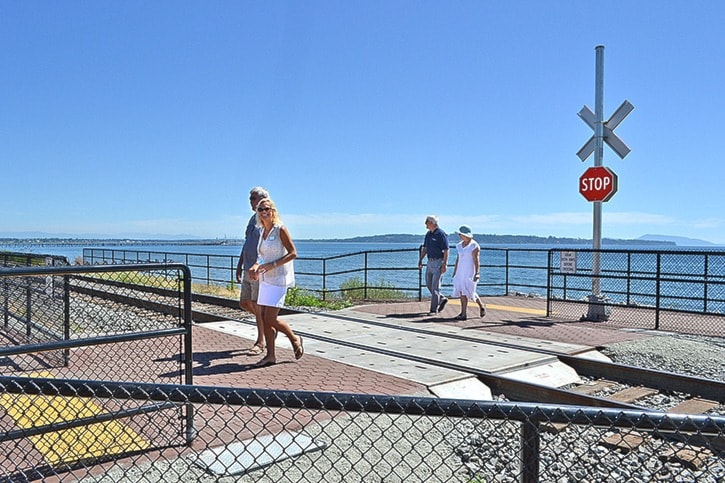Nearly two years after tragedy on White Rock’s waterfront sparked an order to improve safety along the rail line, city officials crossed West Beach tracks with a celebratory step.
“This is a good day for us,” Mayor Wayne Baldwin said Friday, shortly before testing out one of two at-grade pedestrian rail crossings with his wife, Jane, and other officials. “It’s been a journey to get here. There’s more improvements to come, but this is a step along the way.”
The crossings – at Oxford and Anderson streets – were constructed at a cost of approximately $500,000, and replace unmonitored access points that were closed to the public more than a year ago as part of efforts to discourage people from trespassing along the rail line.
The work was ordered by Transport Canada, following the July 2013 death of a jogger who was struck by a passenger train on East Beach tracks.
Baldwin said the Finlay crossing where the jogger was hit and others along the waterfront were “set up in a kinder, gentler time,” when fewer and shorter trains were rolling through on a daily basis.
“Things have changed,” he said. “People’s attitudes have changed. I think Transport Canada recognized that and said ‘you have to make it safer.’”
The work done has made the crossings “much better than they were before,” Baldwin said.
A day earlier, the city’s director of engineering, Greg St. Louis, told Peace Arch News that it’s too soon to say how much the increased access points on West Beach will discourage trespassing, but he is optimistic. In East Beach – where mesh fencing was installed along the promenade hand railing last fall and a six-foot-high, wrought-iron-style fence added for 160 feet east from the Finlay Street crossing – “we’ve been seeing a lot less.”
The concept behind the reduced access in West Beach appeared lost on some visitors last week, however. In the space of less than 30 minutes Thursday afternoon, one teen was seen hopping the railing to access the rip rap, and a photographer lined up a pair newlyweds on the tracks adjacent to the pier for wedding pictures. On Friday, a pair of beachgoers – right in front of city and Transport Canada officials – decided the tracks were a better place to walk their dog.
While Baldwin didn’t specifically address Friday’s flagrant disregard for the safety measures, he did say Transport Canada’s guidelines don’t fit White Rock’s unique position, but didn’t elaborate. At the same time, he said, the federal agency has “shown some understanding for the situation that we’re in.”
Work still to be done includes more comprehensive upgrades – including signals and lights – to the six waterfront pedestrian crossings (Finlay, Ash, Balsam, Cypress and Bay Street, as well as at the pier).
Cost of that work was initially estimated at $1.8 million, however, St. Louis said the final tab will be more.
The city’s 2015-2019 financial plan shows $1.57 million allocated to railway pedestrian crossing work during that time, including $425,000 in 2016 for the Finlay crossing; $620,000 in 2018 for the Bay crossing; and $525,000 in 2019 for the Balsam crossing.
The amounts are expected to be funded up to 50 per cent through Transport Canada’s Grade Crossing Improvement Program.
Of $2.575 million anticipated to be spent after 2019 on the remaining crossings (Ash, Cypress and at the pier head, as well as on signals and lights for the two crossings opened Friday), nearly $1 million may be covered by grants.
St. Louis said that while there has been no talk so far of cost-sharing the work with railway owner BNSF, there will be. He confirmed there is a provision to apply for a decision – should there be a disagreement – on cost apportionment through the Canadian Transportation Agency.
It would be a council decision to take that step, he said.
He noted that a decision to shift hand-railing posts that were installed on the south side of the West Beach tracks a further two feet south was made after BNSF officials suggested the structure was a risk of damage during future track work. The move did not bump up the project’s cost or delay its completion, he said.
